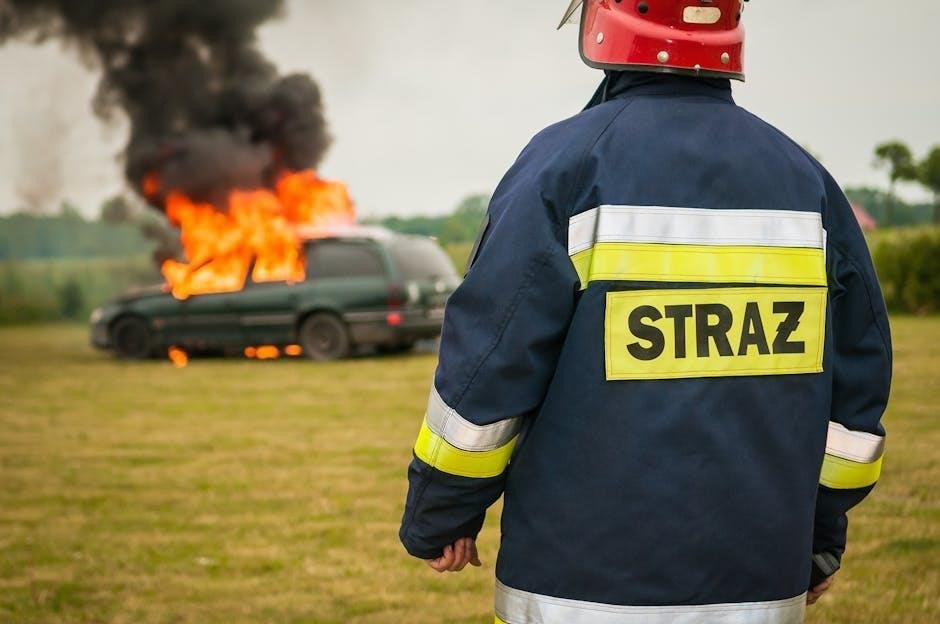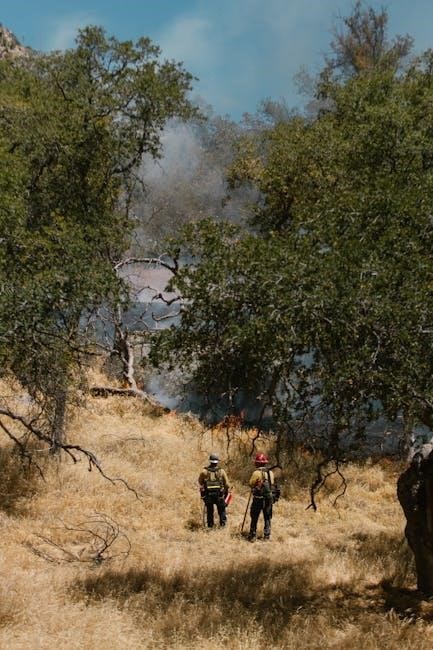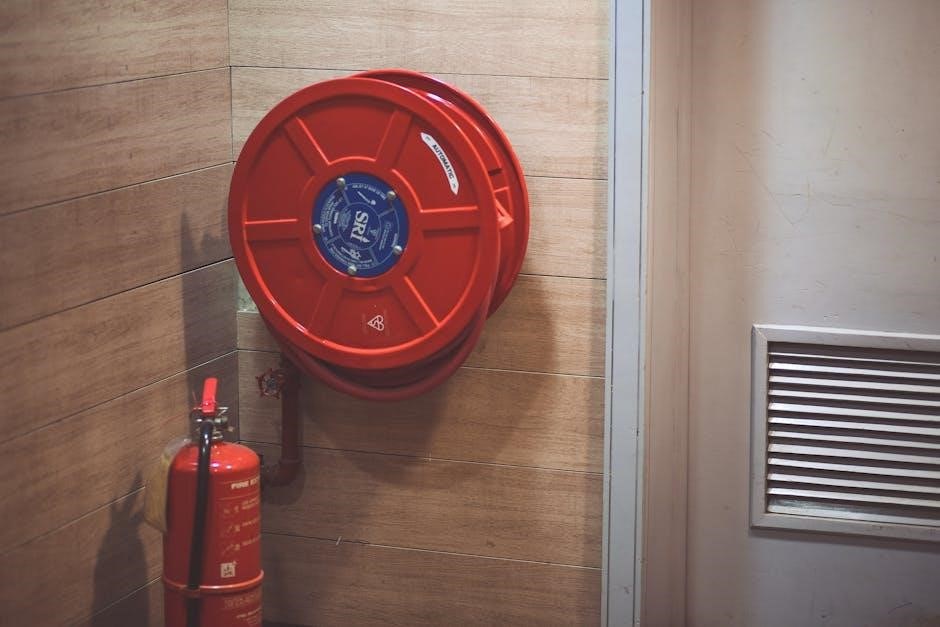
Fire Extinguisher Types and Uses: A Comprehensive Guide
Navigating fire safety demands understanding extinguisher varieties, crucial for mitigating diverse blaze types.
This guide details classifications,
ratings,
and proper usage,
ensuring preparedness
and effective response
to potential fire hazards,
promoting safety for all.

Understanding Fire Classes
Categorizing fires is fundamental to selecting the appropriate extinguishing agent. Fires aren’t all the same; they’re classified into five distinct classes – A, B, C, D, and K – based on the fuel source. Class A fires involve ordinary combustibles like wood, paper, and fabric. Class B fires ignite flammable liquids such as gasoline, oil, and grease. Class C fires involve energized electrical equipment, presenting a shock hazard.
Class D fires are fueled by combustible metals like magnesium, titanium, and sodium, requiring specialized extinguishing agents. Finally, Class K fires occur in commercial kitchens, involving cooking oils and fats. Using the wrong extinguisher can be ineffective or even dangerous, potentially spreading the fire. Water, for instance, can exacerbate Class B and C fires. Understanding these classifications is the first step towards effective fire safety and choosing the correct extinguisher for each scenario.
Class A Fires: Combustible Materials
Class A fires involve common solid materials like wood, paper, cloth, rubber, and many plastics. These are the most frequently encountered fire types in homes and offices. They leave behind ash, hence the “A” designation. Extinguishing these fires primarily focuses on cooling the material below its ignition temperature and soaking the fuel to prevent re-ignition.

Water is highly effective on Class A fires due to its cooling properties, but it’s unsuitable for other classes. Extinguishers for Class A fires are rated numerically, ranging from 1-A to 40-A, indicating the amount of fire the extinguisher can handle. A higher number signifies a larger extinguishing capacity. While water extinguishers are ideal, foam extinguishers also provide effective cooling and a smothering effect, offering added protection against re-flash. Careful selection ensures optimal safety.
Class B Fires: Flammable Liquids

Class B fires are fueled by flammable liquids such as gasoline, oil, grease, solvents, and paints. These fires spread rapidly and can be incredibly dangerous. Attempting to extinguish a Class B fire with water is extremely hazardous, as water can spread the flammable liquid, intensifying the blaze. The key to extinguishing these fires is to smother the fuel source, cutting off its oxygen supply.
Foam and dry chemical extinguishers are the most effective choices for Class B fires. Foam creates a blanket that suppresses vapors and cools the liquid, while dry chemical interrupts the chemical reaction of the fire. CO2 extinguishers are also suitable, displacing oxygen and suffocating the flames. Selecting the appropriate extinguisher is crucial; using the wrong type can worsen the situation and put lives at risk.
Class C Fires: Electrical Fires
Class C fires involve energized electrical equipment, posing a significant shock hazard. These fires can originate from faulty wiring, overloaded circuits, or malfunctioning appliances. Never use water on a Class C fire, as water conducts electricity and can cause severe injury or death. The primary goal is to de-energize the circuit if possible before attempting to extinguish the flames. If de-energizing isn’t immediately feasible, specialized extinguishing agents are required.
Carbon dioxide (CO2) and dry chemical extinguishers are the recommended choices for Class C fires. CO2 extinguishers displace oxygen, suffocating the fire without leaving a residue. Dry chemical extinguishers interrupt the chemical reaction, but may cause damage to sensitive electronic equipment. Once the electrical source is disconnected, the fire can then be treated as a Class A fire if combustible materials are involved.
Class D Fires: Combustible Metals
Class D fires are unique and dangerous, involving combustible metals like magnesium, titanium, sodium, and potassium. These metals burn at extremely high temperatures and react violently with water, potentially causing explosions. Standard fire extinguishers are ineffective and can exacerbate the situation. Attempting to extinguish a Class D fire with the wrong agent is incredibly risky and can lead to severe consequences.

Specifically designed dry powder extinguishers are essential for Class D fires. These extinguishers work by smothering the metal, creating a heat-absorbing crust, and interrupting the chemical chain reaction. The dry powder agent doesn’t react with the burning metal and effectively cools it down. It’s crucial to identify the specific metal involved to select the appropriate dry powder agent, as different metals require different formulations. Never use water, CO2, or standard dry chemical extinguishers on Class D fires.

Class K Fires: Kitchen Fires (Cooking Oils & Fats)
Class K fires originate in commercial kitchens, specifically involving cooking oils and fats – like vegetable or animal fats. These fires burn hotter and are more difficult to extinguish than typical Class B flammable liquid fires. Water reacts violently with hot oils, causing a dangerous splatter and spreading the fire rapidly. Standard ABC extinguishers are also ineffective and can worsen the situation, posing a significant hazard to kitchen staff.
Class K fire extinguishers utilize a wet chemical agent, typically potassium acetate, potassium citrate, or potassium carbonate. This agent saponifies the burning oil, forming a soapy foam blanket that smothers the fire and cools the oil below its ignition temperature. These extinguishers are specifically designed with a nozzle that gently applies the agent to avoid splashing. Proper training is vital for effective use, ensuring the agent covers the entire burning surface and prevents reignition.
Types of Fire Extinguishers
Selecting the correct fire extinguisher is paramount for effective fire suppression, as different types are designed for specific fire classes. Water extinguishers excel on Class A fires, cooling the material below its ignition point, but are dangerous on flammable liquids or electrical fires. Foam extinguishers tackle both Class A and B fires, creating a barrier that prevents reignition. Dry chemical extinguishers, available in multi-purpose (ABC) and specific (BC) formulations, interrupt the chemical reaction of the fire.
Dry powder extinguishers are crucial for Class D fires involving combustible metals. Carbon dioxide (CO2) extinguishers are ideal for Class B and C fires, displacing oxygen and leaving no residue. Understanding these distinctions is vital; using the wrong extinguisher can escalate the situation. Regular inspection and maintenance are also key to ensuring operational readiness when a fire emergency arises.
Water Fire Extinguishers: For Class A Fires
Water fire extinguishers are specifically designed for Class A fires, which involve combustible materials like wood, paper, and fabric. These extinguishers operate by cooling the burning material below its ignition temperature, effectively extinguishing the flames. They are highly effective and relatively inexpensive, making them a common choice for general fire protection in homes and offices. However, it’s crucial to understand their limitations.
Never use water extinguishers on Class B (flammable liquids) or Class C (electrical) fires, as this can spread the fire or create a dangerous electrical shock hazard. Water conducts electricity and can cause the flammable liquid to splatter, intensifying the blaze. Extinguishers are rated numerically, indicating the amount of fire they can handle – from 1-A to 40-A. Proper training and understanding of these limitations are essential for safe and effective use.
Foam Fire Extinguishers: Class A & B Fires
Foam fire extinguishers offer versatility, effectively tackling both Class A (combustible materials) and Class B (flammable liquids) fires. They work by creating a cooling effect and smothering the fire with a foam blanket, preventing reignition and suppressing flammable vapors. This makes them particularly useful in areas where both types of fire hazards exist, such as garages or workshops. A key advantage is their reduced mess compared to dry chemical extinguishers.
However, foam extinguishers are not suitable for Class C (electrical) fires due to the water content, which poses an electrocution risk. They also aren’t ideal for outdoor use or large Class A fires. Selecting the correct extinguisher – ABE or BE – is vital, as they differ in capabilities. Proper training is essential to ensure safe and effective operation, maximizing their protective benefits.
Dry Chemical Fire Extinguishers: Versatile Options
Dry chemical fire extinguishers represent a widely utilized and versatile solution for fire suppression, employing a powdered agent to interrupt the chemical reaction of a fire. These extinguishers are effective against multiple fire classes, depending on the chemical compound used. They function by coating the fuel source, creating a barrier between the oxygen and the burning material, quickly extinguishing flames. This rapid action makes them ideal for initial fire response.
However, dry chemical extinguishers leave a powdery residue that can be corrosive and difficult to clean. Furthermore, the discharged powder can reduce visibility. While effective, they aren’t the best choice for sensitive electronic equipment. Different formulations exist, leading to specialized types like ABC and BC extinguishers, each tailored for specific fire hazards.
ABC Dry Chemical Extinguishers
ABC dry chemical extinguishers are the most common and versatile type, designed for use on Class A, B, and C fires. This multi-purpose capability stems from the use of monoammonium phosphate as the extinguishing agent. It smothers Class A fires (ordinary combustibles) by cooling and creating a coating, interrupts the chemical reaction of Class B fires (flammable liquids), and insulates against electrical current in Class C fires (energized electrical equipment).
Their widespread availability and broad-spectrum effectiveness make them a popular choice for homes, offices, and vehicles. However, remember the residue left behind can be corrosive and cleanup can be extensive. While incredibly useful, ABC extinguishers aren’t ideal for delicate electronics due to potential damage from the powder. Regular inspection and maintenance are crucial for reliable operation.
BC Dry Chemical Extinguishers
BC dry chemical extinguishers are specifically designed to combat Class B (flammable liquids) and Class C (electrical) fires. They utilize sodium bicarbonate or potassium bicarbonate as the extinguishing agent, interrupting the chemical chain reaction that sustains the fire. Unlike ABC extinguishers, they are not effective on Class A fires – attempting to use them on ordinary combustibles will likely be ineffective and could spread the fire.
These extinguishers are commonly found in areas where flammable liquids are present, such as garages, workshops, and kitchens. They are also suitable for electrical rooms and around sensitive equipment. Like ABC extinguishers, BC types leave a powdery residue that can be corrosive and require thorough cleanup. Proper training and understanding of fire classifications are essential for safe and effective use.
Dry Powder Fire Extinguishers: For Class D Fires
Dry powder extinguishers are uniquely formulated for Class D fires, involving combustible metals like magnesium, titanium, sodium, and potassium. These metals burn at extremely high temperatures and react violently with water, making standard extinguishers ineffective and dangerous. Dry powder agents work by smothering the metal fire, creating a crust that excludes oxygen and dissipates heat.
These extinguishers utilize specialized powders, often sodium chloride-based, specifically chosen for the metal involved. Identifying the specific metal is crucial for selecting the correct extinguishing agent. Dry powder extinguishers are typically found in laboratories, factories, and industrial settings where these metals are used or stored. They are marked with a lilac label (formerly blue) and require specialized training for proper application, as incorrect use can exacerbate the situation.

Carbon Dioxide (CO2) Fire Extinguishers: Class B & C Fires
Carbon dioxide (CO2) extinguishers are highly effective against Class B fires – flammable liquids like gasoline, oil, and grease – and Class C fires, involving energized electrical equipment. CO2 extinguishes fires by displacing oxygen, effectively suffocating the flames without leaving a residue. This makes them ideal for sensitive electronic environments where damage from other extinguishing agents could be costly.
CO2 extinguishers discharge as a cold, white gas, and their range is relatively limited. They are particularly useful in enclosed spaces, as the CO2 concentrates and enhances its extinguishing power. However, because CO2 displaces oxygen, use in confined areas requires caution to avoid asphyxiation. These extinguishers are often found in laboratories, mechanical rooms, and near electrical panels. Remember, CO2 has limited penetration, so direct application is vital.
Fire Extinguisher Ratings and Selection

Selecting the appropriate fire extinguisher hinges on understanding its rating, which indicates its extinguishing capacity. Ratings are crucial for matching the extinguisher to the potential fire hazard. For Class A fires (ordinary combustibles), extinguishers are rated numerically – 1-A, 2-A, up to 40-A – signifying the amount of fire a trained operator can extinguish. Higher numbers denote greater extinguishing power.
Class B and C extinguishers utilize a lettered system, often combined (e.g., BC, ABC). The numbers preceding the letters indicate the approximate square footage of a Class B fire an extinguisher can handle. Proper selection involves assessing the specific risks present – flammable liquids, electrical equipment, or ordinary combustibles – and choosing an extinguisher with a rating suitable for those hazards. Always prioritize extinguishers certified by a recognized testing laboratory.
Extinguisher Rating System (Numerical Ratings for Class A)
The numerical rating system for Class A fire extinguishers quantifies their effectiveness against ordinary combustible materials like wood, paper, and fabric. These ratings, ranging from 1-A to 40-A, aren’t measurements of extinguishing agent volume, but rather represent the equivalent water extinguishing capacity. A 1-A rated extinguisher can extinguish a fire equivalent to 1.25 gallons of water.
Higher numbers indicate a greater extinguishing capability; a 40-A extinguisher is equivalent to 50 gallons of water. When selecting an extinguisher for Class A hazards, consider the potential fire size and the environment. Larger areas or substantial combustible material accumulations necessitate higher-rated extinguishers. Understanding this system ensures you choose an extinguisher capable of effectively controlling a Class A fire, enhancing safety and minimizing damage.

Choosing the Right Extinguisher for Specific Hazards
Selecting the appropriate fire extinguisher is paramount for effective fire suppression and safety. Matching the extinguisher type to the anticipated fire hazard is crucial; using the wrong extinguisher can worsen the situation. For example, water on a flammable liquid (Class B) fire will spread the blaze. Homes require multi-purpose ABC extinguishers to address common hazards like electrical, paper, and cooking oil fires.
Vehicles benefit from BC or ABC extinguishers, addressing fuel and electrical fires. Workplaces should have extinguishers tailored to their specific risks – flammable materials, electrical equipment, or combustible metals. Always prioritize extinguishers with ratings suitable for the potential fire size. Proper selection, combined with training, ensures a swift and safe response, minimizing damage and protecting lives.

Fire Extinguisher Maintenance and Inspection
Regular maintenance and inspection are vital for ensuring fire extinguisher reliability. Monthly visual checks should confirm the extinguisher is accessible, fully charged (gauge in the green zone), and free from physical damage like corrosion or dents. Annual professional inspections, conducted by a qualified technician, are legally required in many jurisdictions. These inspections involve a thorough examination of the extinguisher’s components, including the hose, nozzle, and operating mechanism.
Hydrostatic testing, every 5-12 years depending on the type, verifies the cylinder’s strength. Keep detailed records of all inspections and maintenance. A compromised extinguisher is useless in an emergency; proactive upkeep guarantees functionality when needed, potentially saving lives and property. Remember, a well-maintained extinguisher is a critical component of a comprehensive fire safety plan.
Fire Extinguisher Procurement Market Intelligence
SpendEdge’s recent report highlights a dynamic global fire extinguisher market, driven by increasing safety regulations and heightened awareness of fire risks across industries; The report details key supplier landscapes, pricing trends, and cost-saving opportunities for procurement professionals. It identifies major players and analyzes their strategies, offering insights into potential partnerships and negotiations.
Demand is rising for specialized extinguishers, like those for Class K (kitchen) fires and Class D (combustible metals) fires, alongside traditional ABC models. Procurement intelligence reveals a shift towards sustainable and eco-friendly extinguisher options. Understanding these market dynamics is crucial for optimizing procurement strategies, ensuring cost-effectiveness, and securing reliable supply chains for this essential safety equipment. The report provides actionable intelligence for informed decision-making.